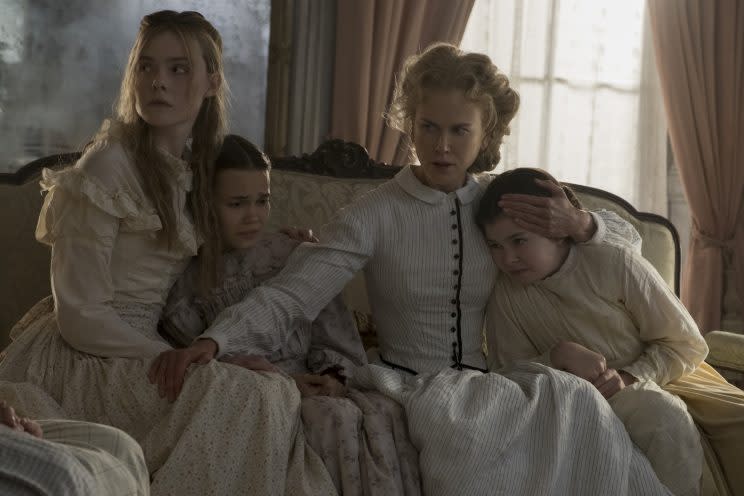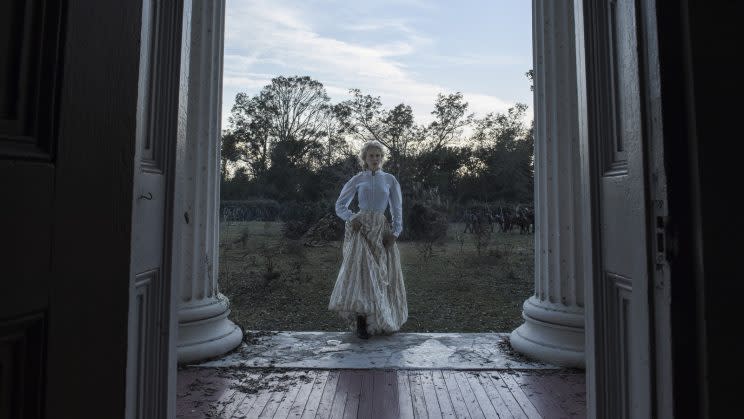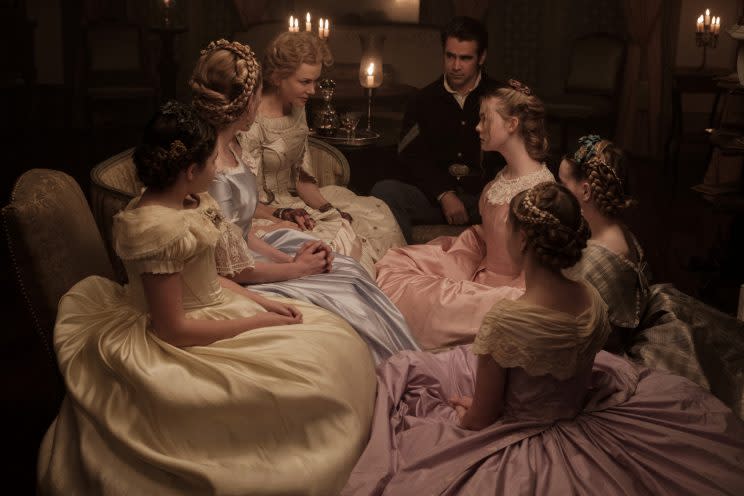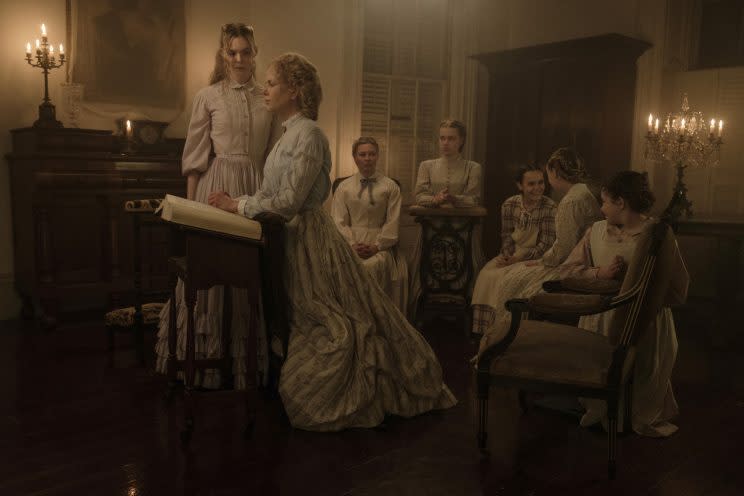Costume Designer on Nicole Kidman’s Look in ‘The Beguiled’: ‘It’s Eerie, It’s Beautiful’

Sofia Coppola’s latest film, The Beguiled, is creepy. It’s eerie, convoluted, mysterious, and sexually fraught. It takes place at Miss Farnsworth’s Seminary for Young Ladies, a girls’ school run by Miss Martha Farnsworth (played by Nicole Kidman), which, due to the Civil War raging right outside their Virginia doors, is now only home to a single teacher, Miss Martha (played by Kirsten Dunst), and four students (one of whom is portrayed by Elle Fanning). The narrative, derived from a 1966 novel and a 1971 film starring Clint Eastwood, revolves around a wounded soldier (Colin Farrell) taking refuge in the Greek revival mansion, and how, with a man in their midst, the girls’ collective mood changes — as does the detail and care with which they dress and present themselves. Gothic and layered, the entirety of this highly stylized film is visually gorgeous. And that’s in large part due to the ethereal costumes designed by Stacey Battat.
Battat (who previously worked with Coppola on The Bling Ring, Somewhere, and A Very Murray Christmas) says the original look of the film came out of extensive conversations with Coppola and the film’s production designer, Anne Ross.
“We talked a lot about the overall visuals of the movie,” Battat tells Yahoo Style. “We talked a lot about them [the women] feeling like ghosts who had been left behind, and creating a world that looked airy and diaphanous and light. It’s eerie, it’s beautiful.”

Ghosts is an apt way to describe the women who roam the aging mansion in pastel colored, finely printed floral dresses, clinging to normalcy amid a life ravaged by war. The head of the house, Miss Martha, does what she can to keep the standards of decorum up to snuff, though the reality of wartime and the women’s isolation leads to elements of a lax wardrobe — like the noticeable absence of hoop skirts.
“Women in that time would have changed multiple times per day,” Battat explains. “These were women who would have gotten dressed for lunch, for tea. But because these particular women were stuck in this house and didn’t have social lives, at some point they kind of stopped dressing.”
That said, Battat made a conscious decision to not make all style standards go to pot. “Miss Martha does not allow sloppy ladies in her household,” Battat says. “We talked about that a lot. In the beginning, we considered that maybe in the opening scene it was so hot that some of them were just sitting in petticoats and corsets, which would have been a really beautiful image. But in the end we were like, ‘Miss Martha would never allow that.’ At Miss Martha’s you have to get dressed, even if there is no one there to see you. You can’t just wear your pajamas all day.”
Of course, the level of dress among the ladies is amped up when they take in the wounded Union soldier. Tiny details — a broach here, a ribbon there — were added to demonstrate that with the soldier in the house, the women now feel like they have someone for whom to dress up.

“We were very true to the period,” Battat says of the costuming choices. “Except for colors.”
Rather than having the women in black — which many American women wore during the Civil War as they were in mourning for a lost soldier — Battat notably styled the women in pastels (a choice in keeping with the ethereal mandate). She also made the vast majority of the costume pieces, or had them made. “I like being able to make clothes,” she says. “It really adds an element to the film — you can control your color palette and you can do things to make it appeal to a modern eye.”

Coppola won the Best Director prize at Cannes for the film, but since opening in the U.S. last week, The Beguiled has been plagued by a “whitewashing” controversy. Coppola’s version of the film removes a female slave character, prominent in both the novel and original film, and casts Dunst in the role of Edwina Morrow (a mixed-race character in the book). The absence of characters of color in the film is explained in one line: “The slaves left.”
In an article on the topic for The Root, Clarkisha Kent writes of Coppola, “because she didn’t want to portray the protagonists of her ‘white [girl] power’ film as slave owners or people who were A-OK with owning slaves, she opted to leave them out entirely.”
Battat adds a different opinion on that topic. “We did talk about how we left her [the slave character] out, and Sofia has mentioned, and I think she’s right, that if we weren’t not making a movie that is primarily about race we didn’t want to just glaze over it.”
She adds, “I think the nuance that people miss is that this is a movie that takes place in the Civil War, but it’s not about the Civil War. I feel like it’s a movie about these women that are trapped, that don’t have options, and how they express themselves.”

However you read the film and its surrounding controversy, the visuals do stick. “It’s about the dynamic of the women in the house and them exploring their sexuality,” Battat says of the film and of the clothes — and about what sexuality even means in 1864 Virginia, when you’re swaddled in layers and fear and petticoats.
The Beguiled opened in Los Angeles and New York on June 23, and everywhere June 30.
Read more from Yahoo Style + Beauty:
? Alison Brie on her ‘GLOW’ Body: ‘I Feel So Strong’
? Couple Celebrating 68 Years of Marriage Pose for Adorable Photo Shoot
? Yoga May Be More Dangerous Than You Thought
Follow us on Instagram, Facebook, and Pinterest for nonstop inspiration delivered fresh to your feed, every day. For Twitter updates, follow @YahooStyle and@YahooBeauty.

